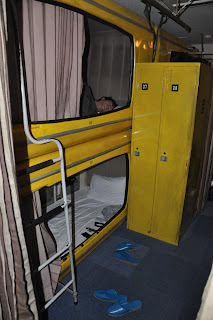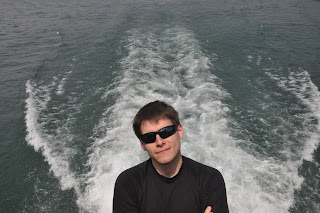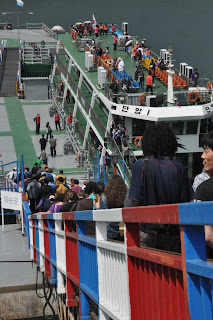Alas, the culmination of excitements and anticipations for the month of May have come to a close. Last weekend, in lieu of Buddha's Birthday, we ventured beyond the boundaries of Korea to a much different and similar culture, Japan. During the Tokyo weekend, the four of us (who have been previously mentioned) toiled in the biggest city in the world. Fortunately our experiences in Seoul helped prepare us well for this weekend. Culture shock was to a minimum and nearly non-existent which allowed us to experience a much different side of Japan.
We left Seoul at 6:45 pm on Thursday night and arrived in Tokyo at 8:45pm, a lovely two hour flight (which, I might add, is insufficient if you are watching Forest Gump. I guess that was my fault and should have watched something else). The picture above perfectly encapsulates our curiosities, and above all, confoundedness with the Tokyo metro. Throughout the whole weekend we were (purposely and inadvertantly) comparing and contrasting Tokyo with Seoul, using a point system. If we found something in Tokyo that pleased us which lacked in Seoul, we gave Tokyo a point and vise versa. The Tokyo metro system racked up about a total of -(negative)100 points. The problem with the Tokyo metro is that it is not the Seoul metro, arguably one of the nicests metros in the world (from my standpoint, which could be correct). Tokyo had a great idea to make a enormous metro system way back when (a no brainer for all large cities), and in doing so, created an enormous deficit. In order to relieve that deficit, they decided to privatize their metro system. A privatized metro system means that if you buy, say, an all day ticket on metro A (for $12.00, which is exactly what we did) that all day ticket is rendered worthless on metro B. Lamezoids. Taxi cabs in Tokyo also are ridiculously expensive. More on expense later (note our trip to Ireland, I get bitter with expensive countries and lame currencies).
Capsules
During our stay in Tokyo, we had the privilege of sleeping in a hostel which consisted of capsules in an area of Tokyo called Asakusa. These capsules, as the reader can gather from the picture, are bunk bed style capsules. Each capsule is equipped with their own TV, light, clock, and radio. We also had our own personal locker. There were about 8 beds in a room. You also had your own personal draw shade for privacy. Hostel experiences are always interesting, and while you sacrifice some luxury, they offer the cheapest means to travel. These cost about $15.00 a night. In a city like Tokyo, you need to cut costs where you can, or else you're going to spend a literal fortune.
A 'Pete's Eye View' from inside my personal capsule. The TV's were worthless because, well, I don't speak Japanese. I thought these were very comfortable, once I accepted the fact that it was possible I was going to get attacked by bed bugs (I didn't, however).
Ueno Zoo
The first leg of our Friday morning consisted of visiting Ueno Zoo. This was a very large zoo in Tokyo and had several interesting animals. They also had a Giant Panda but it died of heart failure last year. I felt a piece of my life fall apart when I heard the news.
Watching an elephant.
Lemurs.
This is a Japanese Macaque. Do not be fooled by this deceptive picture of one joyfully playing on a swing. There was actually an epic battle in the Japanese Macaque ring. There were about 30 of these things and there was a showdown. This Macaque was either fleeing from aparent danger, or creating havoc on the rest of the clan. It was fun to watch.
Sumo
We were really intentinal about going to a Sumo Wrestling match while in Tokyo because Sumo is very cultural in Japan. It is a very old sport and one of the only sports in the world that verily holds on to its traditional customs thousands of years ago. The only Sumo arena in Tokyo is in Ryogoko. A ticket to a match was about $50.00 for the nosebleeds, but that ticket lasts all day. Wrestling starts at about 8:00 am and finishes around 6:30pm. It is up to you when you want to go watch the matches. The beginner uber noobs wrestle early in the morning and the heavyweight champions wrestling later in the day, starting at 4:30pm.
One of the things I liked so much about Sumo was how traditional and old the sport is. Every movement in the ring seemingly had some sort of significance. Before wrestling while they are in a squatting position they clap very loud to "get the attention of the gods". The very famous "large stomp" as you see in the picture above symbolizes the wrestlers attempt to "rid the wrestling ring of evil" before the match. The more experienced wrestlers, who have more respect, are able to throw salt in the ring to "bless and prevent any injuries."
The coolest aspect about Sumo was also it's lamest. When you think of a typical sport, especially in Western civilizations, it is very fast paced. Sumo wrestling is almost more ritual than actual wrestling. Up until about a decade ago (possibly more) they put a time limit on the 'pre-rituals' of each match. The time limit now is 4 minutes, whereas there used to not be a time limit. There is a lot of 'face off' and intimidating between the wrestlers and it is actually a very calm sport to watch. The matches themselves only last about 4-7 seconds. The wrestlers only aim is to either make his opponent fall on the ground or push them outside of the ring. A very simple concept.
Tsukiji Fish Market
On Saturday morning, very early in the morning, we went to the biggest fish market in the world. Tsukiji Fish Market. We left our capsule around 5:30 am and got to the market around 7am or so and watched the literal insanity.
There was fish everywhere and a lot of death. Fish heads were a flyin' and blood was spilled in the name of the sushi gods. There were a lot of interesting fish, dead of course, to look at. The most interesting, were, the ....
Tuna. These fish are pretty massive and I have got to credit these guys for the efficiency of the way they clean them. First they gut the unfortunate beasts, then they freeze them, and then cut them to pieces on a large band saw. They cut the head off then cut right down the spine in a matter of seconds. There are a lot of tuna that go through these parts on a daily basis. Japan loves fish.
Tokyo Tower
After the fish market, we meandered around Tokyo for a few hours until we decided to go to Tokyo Tower. Tokyo Tower, interestingly looks very similar to the Eiffel Tower, and is actually 9 or so meters higher than the Eiffel.
What we liked so much about Tokyo Tower was that it was in the heart of Tokyo, offering excellent views of the city. It was a beautiful day and very clear. You can find more pictures on the web albums.
City Night Tour
On Saturday night we went on a city night tour. This tour was about 4 hours and we were able to learn a little more about Tokyo and see some of the night life. We were able to go up to Mori Tower and get some excellent night views of Tokyo. The tour also included a delicious meal at the top of the Washington Hotel.
It was a fantastic short trip. This past weekend got the sweet taste of travel in our mouths and we are already looking forward to the next place of adventure to take place. We already have tickets for Hong Kong and Shanghai at the end of July and we are now anxiously awaiting that trip as well. It was good to finally experience one of the reasons why we decided to come to Korea in the first place, which was to see this part of the world at an affordable price.




























